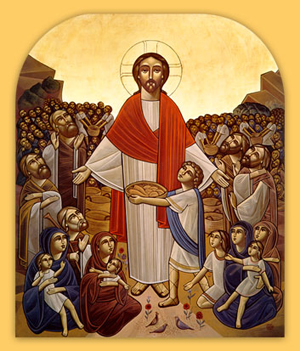I've been experimenting with reading the Gospels in a way that's different from the methods I grew up with. Instead of reading through an assumed first-century lens, I've been trying to imagine what Jesus' miracles would look, sound, feel, and taste like if they happened here and now. How would I — a woman in twenty-first century America — respond? How would Jesus' words and actions register in the culture I live in?
This week, I focused on Jesus' feeding of the five thousand, a story I usually read in its first-century context of poverty, exploitation, and hunger. In its original setting, I can easily imagine how Jesus' actions would have resonated. Crowds flocked to him because they were colonized peasants. Overworked, underpaid, malnourished. They knew the terror of an empty table. The agony of watching their children cry for bread.
Me? Not so much. I've never been hungry like that. I've never had to wait more than a few hours for a meal. So where is the resonance — the challenge, the indictment, the power — of this miracle for me?
I didn't know until I read the story (St. Marks' version of it, in chapter six of his Gospel) over and over and over again. It hit me, finally, as I lingered over verse 42: "And they all ate and were satisfied." Satisfied. They ate, and were satisfied.
I sat with that verse for a long time. How often, I asked myself, do I eat and feel satisfied? Only satisfied? How often does the culture I live in allow me to experience food as a gift?
Not often enough. If Jesus' bread-and-fish miracle happened in my world right now, I would have to rewrite verse 42. Do any of these rewrites sound familiar?
"They ate, and felt guilty."
"They ate, and hated themselves."
"They ate, and looked around to see if they'd eaten more or less than the people sitting next to them."
"They ate, and started calculating: 700 calories? 900? How long on the treadmill to undo this damage?
"They ate, but only the fish, not the bread. You know. Carbs."
"They ate, and planned to throw up afterwards."
"They didn't eat. They gorged."
"They didn't eat. They pretended to."
When I was little, my parents, brother, and I often spent our summers in rural south India, visiting our extended family. Food was central to those visits. I still remember how my grandmother chased down poultry, haggled with the fish-sellers, sent a farm-hand up a tree to cut down coconuts, gathered peppers and green beans from her garden, and hand-ground spices on a slab of stone in the backyard to make the mouth-watering curries she took such pleasure in feeding us.
In her world, food was a gift. To prepare it with care was an act of generosity and deep love. To receive it with gratitude was a matter of honor and respect. As my mother constantly reminded me when we had to visit several relatives in one afternoon, and every last one of them insisted on stuffing treats into my mouth: "Eat something. At least a bite. There's no worse insult you could offer than to refuse their food."
In contemporary Western culture, though, it's much harder to honor food as a gift. We tend to treat it like dynamite. Often, we carry our beautiful hors d'oeuvres to our church potlucks, circle the laden tables with fear in our eyes, nibble a little here and a little there — always afraid of who might be watching — and then carry our beautiful, barely-touched dishes home again. Where perhaps (shall we be honest?) we sit down alone and lick them clean before the guilt sets in.
 I'm not judging anyone; I think we've come by the problem honestly. Jesus' feeding miracles were intended to speak abundance into a culture of scarcity. But we live in a culture of excess. Excess messaging, packaging, consuming, dieting. We hardly know how to hear the word "abundance" in a positive light; we're too scared of its dangers to trust in its promise. For some of us, food is a burden. For others, an enemy. For still others, an addiction coated in secrecy and self-loathing.
I'm not judging anyone; I think we've come by the problem honestly. Jesus' feeding miracles were intended to speak abundance into a culture of scarcity. But we live in a culture of excess. Excess messaging, packaging, consuming, dieting. We hardly know how to hear the word "abundance" in a positive light; we're too scared of its dangers to trust in its promise. For some of us, food is a burden. For others, an enemy. For still others, an addiction coated in secrecy and self-loathing.
When Jesus fed the multitudes, people sat down together, taking only what they needed so that everyone got enough. The point was not to scheme, conserve, or quantify. The point was not to clamor for more. The point, very simply, was to enjoy the gift of a single day's portion in the company of others. Abundance didn't have to lead to gluttony. Food didn't have to lead to fear, isolation, and shame.
But when Jesus fed the multitudes, he was also acknowleding what we so often try to forget: that we are physical beings, with legitimate physical needs. We're not airy spirits; we have bodies, and those bodies themselves are gifts from God. Gifts worthy of honor and care.
In her courageous book, See Me Naked: Stories of Sexual Exile in American Christianity, Amy Frykholm documents the many ways in which contemporary Christians live in estrangement from their own bodies. In one of her stories, she describes what happened to a visual artist named Monica when she first encountered a nude model in an art class:
"The model came out and seated herself. Monica felt a wave of repulsion. The woman serving as a model for this drawing was nothing that she had expected. She was, for one thing, fleshy. You could see pockets of cellulite on her thighs and collected fat at the tops of her arms and at her hips. Under the lights, you could see places where she had missed shaving. She was human, a human body, and that not only surprised Monica; it made her nauseous. The words that came to her mind embarrassed her: revolting, ugly, disgusting."
I recognize Monica's repulsion; it plays out in our culture all the time. It's the repulsion that makes a forty-year-old feel hideous if she doesn't look twenty. The repulsion that tells a teenager she's fat if her thighs touch. The repulsion that celebrates photo-shopped Victoria's Secret models over the real curves of real women. The repulsion that fuels multi-million dollar diet and cosmetics industries.
A couple of years ago, I read An Altar in the World, Barbara Brown Taylor's book on useful modern-day spiritual practices. I was cruising along just fine until I got to a chapter entitled, "The Practice of Wearing Skin," and read this sentence: "Whether you are sick or well, lovely or irregular, there comes a time when it is vitally important for your spiritual health to drop your clothes, look in the mirror, and say, 'Here I am. This is the body-like-no-other that my life has shaped. I live here. This is my soul's address.'"
I remember I laughed out loud. In fact, I called a couple of friends and laughed out loud with them. "She's got to be kidding, right?" I said. "Pray naked? No way."
Why no way? Well, to pray naked would be to acknowledge that this body of mine is acceptable to God. No, more than that. To trust that this body — flawed as it may be in my own eyes — is a gift from God, precious to the Giver, and so entirely worthy of my satisfaction as its recipient.
They ate and were satisfied. Is this because they ate in the presence of Jesus? What would that be like? To invite him to my table? To let him watch and partake as I eat? To welcome the Incarnate Jesus into my "soul's address?" Where might such brave communion lead?
In the end, Jesus' feeding miracles were his self-revelations. He gave bread because he is Bread. He fed hungry bodies because he, too, inhabited and honored a body.
There are no easy answers here. All I have is prayer. Lord, be known to us. In our own bodies, which are your temple. In the giving and receiving of good gifts. In the breaking of the bread.
Image credits: (1) Wikipedia.org.



